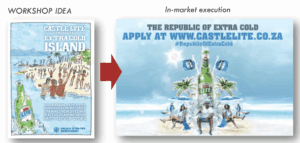“Have you ever had a good idea from a brainstorm?” asked Claire Ashman, CEO of agency Reveller, in a recent Linked In post (1). “I’ve always hated them. The pressure, the panic.” I’d agree that classic brainstorming meetings are often a waste of time. However, workshops can be highly effective if, and it’s a big if, they are expertly designed, planned and facilitated. Such workshops have played a key role in most of our brandgym projects.
Marketing directors seem to agree that workshops can work. 63% believe workshops will become more important in the next 2-3 years, based on our recent research on brand strategy in an age of AI.
Below I share some top tips for workshops that work, inspired by 30 year’s of facilitation experience in 1000’s of workshops.
1: Cast the right team
Having to work with “the loudest people with the worst ideas,” is one reason Claire hates brainstorms. This does indeed sound horrible. If this sort of “toxic” team member does turn up, an expert facilitator can help manage them! But fortunately it happens rarely if you “cast” the right team.
We recommend a team made up of a range of people with different skills and expertise. And only those who will make an active, positive contribution: no passengers or observers (or workshop wreckers!). Second, limit the group to c.12-15 people.
In addition, every workshop should be led by a core group of 2-3 people, responsible (with power to make change happen) and deep-thinking (smart and focused on the right issues). This core team work intensively before a workshop to start creating hypotheses, brand & business insights and “idea fuel” (more on this later). After the workshop this core have ownership to turn vision into action.
2: Invest in “insight fuel”
“The best ideas usually start with curiosity, not a calendar invite,” as Claire rightly points out. This is why weeks before any workshop you need to invest in some potent, fresh “insight fuel” to inspire new thinking.
For example, the new product Solero Shots was born in a workshop like this. Immersive insight into teens’ consumption of soft drinks was fused with product insight from an R&D guy. He turned up with a bag of ice balls he’d made for fun! The fusion of the insight and the product was where the magic happened.
3: Use “parallell” creation of ideas
“I’d much rather grab a couple of people I trust – people with sharp instincts who get the problem – and find the creative solution together,” wrote Claire in her post. This sort of smaller creative team can absolutely be part of a brand growth project process. We tend to use a series of smaller teams to create workshop inputs. This “parallel” creation of ideas maximises the chances of having good ideas to feed into the workshop.
4: Facilitate “friendly feedback”
“Without conversation, tension or real listening, it’s just a bunch of stressed people eating croissants and pretending it’s collaboration,” is how Claire describes her experience of brainstorms. Creating the right collaborative environment does require expert workshop facilitation.
Real listening can be encouraged by allowing presenters to tell their full story, rather than allowing people to jump in with comments from the first minute. Instead, we encourage participants to capture feedback to share at the end of the presentation. This includes what they like and “How to?” improve the idea.
This approach embraces creative tension, by focusing on the good stuff in an idea and working on how it could be brought to life. Working on Castle Lite, an extra cold beer in South Africa, one idea was to build an “extra cold” island floating in the middle of the sea. A couple of people did reply “That’s mad!’” But someone else said “How to do that without building an Island?!”. This led to an activation platform called “The Republic of Extra Cold” which took place on the existing Stanley Island (see below).

True conversation is not easy to create, but can be done with smart workshop design. Smaller breakout groups allow for more informal dialogue. And an exercise we use called “the reflective circle” is a quieter moment when conversation can happens within the group as a whole.
In conclusion, brainstorming meetings can be a waste of time. But workshops can be highly productive and effective, as illustrated by the increase in team clarity and inspiration before and after the workshops we’ve measured, on 400+ participants (below). But for this to happen, you need expert design, planning and facilitation.

SOURCES
